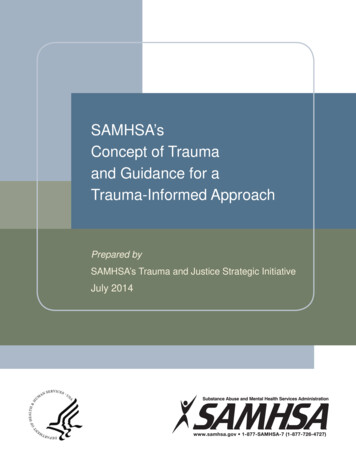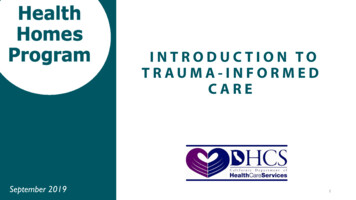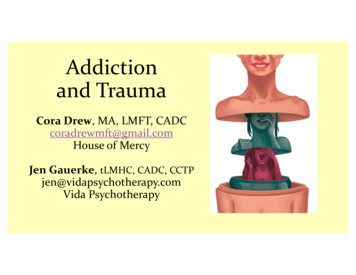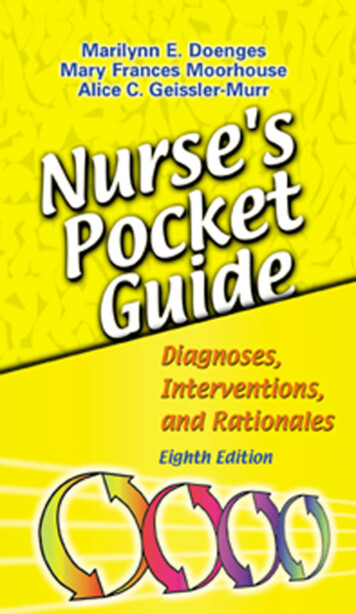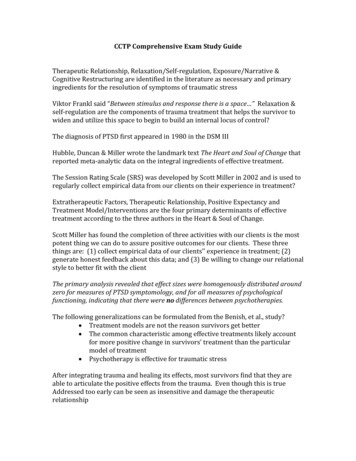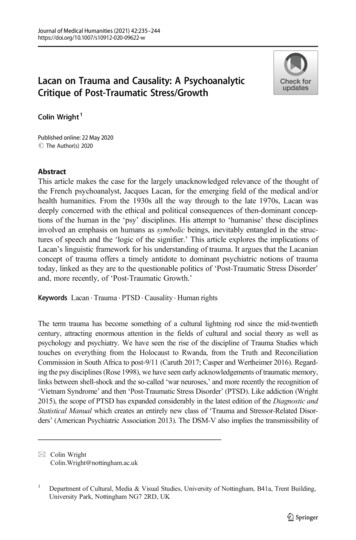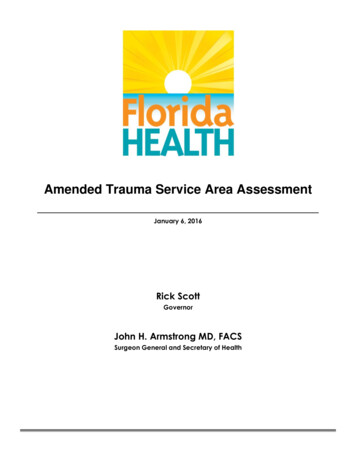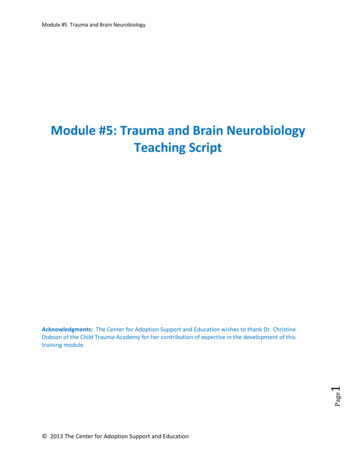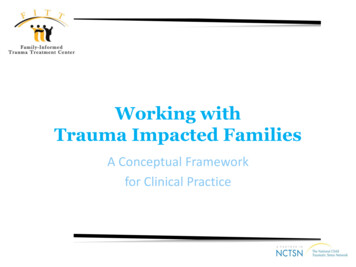
Transcription
Working withTrauma Impacted FamiliesA Conceptual Frameworkfor Clinical Practice
Continuing Medical EducationCommercial DisclosureI, Laurel Kiser, have the following commercialrelationship(s) to disclose: Book royalties Grant support Training and consultation contracts Speakers fees
Learning ObjectivesAs a result of attending this workshop, attendeeswill increase awareness of the contextual conditions or accumulatedtraumatic circumstances that influence families. be familiar with adaptations that families make related toexposure to chronic stress and multiple traumas. determine the clinical implications of these complexadaptations for working with families.
Outline of the Presentation Widening the Lens Overview of Complex Family Trauma– Accumulated Traumatic Circumstances– Adaptations within the Family System Practice Implications
Widening the Lens Core Concepts for Family Trauma– Family provides an interpretative lens through whichfamily members appraise and make meaning of traumaticexperience.– Family has the capacity to serve as a source of risk andprotection regarding a family member's ability to recover.– Trauma ripples throughout the whole family and getsencoded and transmitted through generations.
Widening the Lens Core Concepts for Family Trauma–––Trauma has the potential to alter family subsystem andsystem functioning.Identifying family level needs and strengths that willsupport positives outcomes is critical to interventionplanning and delivery.Families who are traumatized are unlike other familiesseeking help, due to the complexities of their adaptationto the multitude of stressors – including traumaticmemories.
Family Informed Trauma Treatment (FITT) yOutcomesParentingPractices &QualityAdultIntimateRelationsAcute and longer-term effectsIndividual developmentFamily life cycleAdapted from Kiser & Black, 2005
Definition: Complex Adaptationsto Trauma in the Family When family strengths and processes are overwhelmedby accumulated traumatic circumstances families mayexhibit distress and disrupted functioning. Adaptations to trauma in families are determined by:– the intensity, duration, chronicity, predictability, or toxicityof the accumulated trauma, and– the nature of the family’s response.Working definition created with input from the Family InformedTrauma Treatment Toolkit Expert Panel Meeting, October 1 & 2, 2009.
Components ofAccumulated TraumaticCircumstances exposure to multiple and on-going stressors repeated traumas along with associated secondary stressorsincluding continued threats
Example: The Context of PovertySOCIAL & NANCIALINSTABILITYTraumaDAILY HASSLESSOCIAL AND PUBLICINCIVILITIES
Complex Adaptations within theFamily System Adaptation Processes Family Adaptationto Accumulated Traumatic Circumstances– Disturbances in the Family Unit– Reciprocal Distress Reactions– Individual Distress– Lapses in Basic Family Functioning
AdaptationAccumulatedTraumaticCircumstancesdynamic processesthrough whichfamilies changestructures andfunctions to meetcontextualdemandsmodification in afamily system torespond to achange in context
Model of Family Adaptation to TraumaProcessAdaptationFamily Stressor Context Stressors (S1-Sn)Trauma exposure (T1-Tn)Secondary Stressors (SS1-SSn)Historical stressors & traumasThrivingMaintainingFamily Stress Reaction Resource utilizationCo-regulation attemptsShared meaning developsStrugglingFamily Healing Resources Material resources Structure Collaborative coping Connectedness EfficacyFamily Perceptionsand Processing ofStressor ContextFailingFigley & Kiser, 2013
Families Who Thrive Acceptance of stressor Family-centered locus ofproblem Solution-focusedproblem-solving High tolerance Commitment Open, effectivecommunication High cohesionFlexible rolesStructure & predictabilityEfficient resourceutilization Self-efficacy Shared beliefs
Multiple trauma stage ation
Complex and interdependentadaptation processes What works to reduce distress related to one eventmay not work for another although the family maytry it over and over again Adaptations that are positive in one instance may benegative or harmful when used to address a differenttraumatic event Need for ongoing adjustments can create lessefficient and flexible use of coping strategies in thefamily
Clinical Characteristics ofComplex Adaptations toAccumulated Traumain Families anxious anticipatory coping style systemic dysregulations disturbed relations & supports altered schemasindividualdistress coping styles & strategies vulnerability to disorder response dyssynchroniesdisturbancesin the familyunitlapses ordeclines inthe family'sability toserve its basicfunctionsreciprocal distressreactions shifts in needs & relationaldynamics role changes altered subsystem functioning
Family Unit Response anxious anticipatory coping style systemic dysregulations disturbed relations & supports altered schemasdisturbancesin the familyunit
Anxious AnticipatoryCoping Style“anticipatorystress, by its verynature, is acognitiveconstruct whichis ‘learned’[29], p. nReactivity
A Moment to Consider What anxious anticipatory coping style bestfits the Garrett family?
Systemic Dysregulations Chronic wear and tear System no longer efficient at responding tothe environment Alterations in physiological response withinthe family context– Safety system dysregulation– Difficulty modulating negative affect withheightened risk for conflict and violence
Social contextinfluencesthe stressresponsethroughphysiologicaland se
A Moment to Consider In what ways have the Garrett family’s normsregarding acceptable affective and behavioralexpression between family members becomeless effective? In what way does the family environment playa role in children’s physiological functioning?
Disturbed Relations & SupportsIntra-familial Extra-familial Compromised familysolidarityPoor communicationchannelsHeightened levels ofnegativity and conflict Decreased relationalsecurity Family membershiptransitions or dissolutionMistrust– negativerepresentation ofrelationships– suspiciousnessHeightened levels ofnegativity and conflictSocial withdrawal andisolationSupports Difficulty identifyingresourcesDifficulty asking for oraccepting supportCompromised andburned out supportnetworkLimited or absentreciprocityAvoidance of helpseeking
A Moment to Consider How does the traumatic context influencerelationships within the family and itssubsystems? How has the family altered relationships withpeople outside the family unit?
Altered Schemas* Family schemas become consistent withtraumatic exposures– biases or distortions in family appraisal andinferencing– distorted rules, beliefs, and world views*may increase individual family membersvulnerability to PTSD when exposed to trauma(Weingarten, 2004)
Examples of Altered Schemas The world is a dangerous place.People are not trustworthy or dependable.Things usually go wrong for our familyThere is nothing that we can do to prevent bad things fromhappening to us. Our future will be much like our present with nothing goodhappening. We are not able to deal with the things that happen to us andnever will be.
A Moment to Consider In what ways do the Garrett’s altered schemasimpact on the children? Consider how each child’s own schemas mayimpact on sibling relationships. Further, how does the altered schemas ofeach family member impact the family as awhole?
Reciprocal Distress Reactionsreciprocal distressreactions shifts in needs and relationaldynamics role changes altered subsystem functioning
Reciprocal Dyadic ProcessaDistress Related egivingNeedsCaregiving Subsystemc
A Moment to Consider Identify how accumulated traumaticexperiences and its effects decrease Ms.Garrett’s functioning and at the same timeincrease the children’s caregiving needs. How do the interactions of family membersimpact on the caregiving subsystem?
Individual Distressindividualdistress trauma-related disorders coping styles & strategies developmental stage response dyssynchronies
Individual Coping Styles Styles– Problem-focused– Cognitive coping– Behavioral coping– Emotional coping– Social coping– Preventive coping Congruence model of effective coping
Trauma Related Disorders Posttraumatic StressDisorder (PTSD) Complex PTSD Developmental TraumaDisorder, proposed Other vePanic attacksSubstance useAttachment
Continuum of Responses Possiblefor Individuals within the Familyadapted fromBonanno 2004
Response Dyssynchronies Different traumatic exposuresDiffering appraisals of events and contextsContinuum of responsesIndividual, developmentally appropriatecoping strategies and styles Developmental differences in response totrauma
A Moment to Consider Identify how each family members’ responseimpacts on the family unit.
lapses ordeclines in thefamily's abilityto serve itsbasicfunctions1. Struggle, and often fail, toprovide safety, stability, andemotional security2. Low or altered source ofidentification or sense ofbelonging3. Decreased intergenerationaltransmission of protection andattachment4. Limited resources for relatingto the larger community
Practice Implications
Practice ImplicationsThis conceptual framework –reduces blame and encourages strengths basedthinking–encourages systems thinking rather than individualsymptom focus–supports emphasis on building resiliency
Practice Implications, ContinuedThis conceptual framework –puts present day functioning in context–helps with identifying high risk areas that requireincreased focus–helps with clinical supervision–helps with coordination of care with otherproviders, across disciplines
Practice Implications, ContinuedThis conceptual framework –provides a basis for understanding and describing theintervention fundamentals that increase the likelihood ofsuccessful outcomes for these families regardless of thespecific strategies used–helps identify those family interventions that represent“best practices” with this populationUsing a consistent conceptualization, clinicians andfamilies can partner to develop a trauma-focusedfamily service plan.
Five Phase ApproachPhase I: Joining the FamilyPhase II: Understanding and Framing their Trauma ResponsePhase III: Building Healing Coping SkillsPhase IV: Sharing and HealingPhase V: Moving ForwardFigley & Kiser, 2013
Family Trauma Assessments Conceptual framework leads to family traumaassessment methods which identify complexadaptations across the family system. Measures impact of traumatic events and contextualstressors on each member of the family, on familysubsystems, and on the family as a whole.
Family and Trauma InformedTreatment Planning Addresses the multiple pathways along which exposure tochronic and acute stress impacts family members and thefamily unit. Collaborative process to develop a course of action that istailored to families’ needs and strengths and maximizesfamily- and caregiver-level curative factors.
Family Assessment of Needs and Strengths– Trauma (FANS-Trauma)Laurel KiserKay ConnorsSarah GardnerFred Strieder& John Lyons
I. THE FAMILY TRAUMATICCONTEXT Items 1-11 cover different trauma types.sexual abusetraumatic loss/separationphysical abusecommunity violenceemotional abusenatural/manmade disasterneglectpolitical violencemedical eventscultural violencefamily violence
6. FAMILY VIOLENCE - This rating describes the severity of exposure tofamily violence including domestic violence. Domestic violence refers tophysical fighting in which family members might get hurt. Physical abuse is notconsidered here.There is no evidence of family violence.Family member has experienced mild violence between family members.This might include slapping or pushing.2 Family member has experienced moderate violence between familymembers. This might include repeated episodes of family violence but nosignificant injuries requiring emergency medical attention have occurred.3 Family member has experienced repeated and severe episodes ofviolence between family members. This might include when significantinjuries or death have occurred;. weapons have been used;. a restrainingorder is currently in place; or a family member is incarcerated due tofamily violence.List family members exposed:01
Assessing Family Needs &StrengthsSectionII14 items assess the Family UnitIII11 items assess Adult family membersIV11 items assess Child family membersV3 items assess Intergenerational family mattersVI4 items assess Adult Intimate PartnershipsVII9 items assess CaregivingVIII2 items assess Caregiver-Child RelationsIX3 items assess Sibling dynamics
II. THE FAMILY UNITStrengths19. Family Communication24. Savoring andOptimism20. Closeness25. Spiritual/Religious21. Organization26. Family Ritual22. Coping Skills27. CommunityConnections23. Family EfficacyNeeds28. Role/Boundary Appropriateness31. Family Conflict29. Family Sense of Safety32. View of the World30. Family Affect Management
30. FAMILY AFFECT MANAGEMENT – This item refers to the family unit’sprocess of initiating, maintaining, or modulating the occurrence, intensity, orduration of emotion-related discourse across a whole range of emotions.0123Family unit displays no difficulties co-regulating emotional responses. Family membersrecognize and respond appropriately to the affect expressed. Family is able to express strongemotions, both positive and negative, when appropriate, and maintain control. Emotionalresponses are appropriate to the situation.Family unit displays some minor difficulties with affect regulation. Family members generallyrecognize and respond appropriately to the affect expressed, but there are some miscuesand miscommunications. Family could have some difficulty tolerating and expressing intenseemotions and become uncomfortable in response to emotionally charged stimuli. Familymembers may be more watchful or hypervigilant in general.Family unit displays moderate problems with affect regulation. Family may exhibit markedshifts in emotional responses (e.g., from sadness to irritability to anxiety) or have containedemotions with a tendency to lose control of emotions at various points (e.g., normallyrestricted affect punctuated by outbursts of anger or sadness). Family may deal effectivelywith positive emotions but may be unable to tolerate or express negative affect. At times,family members’ affect may be inconsistent with the situation.Family unit displays severely dysregulated affect. Affective communication among familymembers is often misunderstood. Family members demonstrate severe problems asevidenced by unpredictable mood and inability to modulate emotional responses (feelingout of control of their emotions or emotionally “shut down”). Family may exhibit tightlycontained emotions with intense outbursts under stress. Affect expressed is generally notconsistent with the situation.
Family Unit Needs and Strengths
Therapeutic Objectives Building Rapport and Trust Rebuilding Safety: Eliminating Unwanted Consequencesof Trauma Re-Establishing Structure and Regulation Building Family Social Supportiveness Developing New Rules and Skills of FamilyCommunication Sharing the Family Trauma Story Building a Family Healing TheoryFigley & Kiser, 2013
ModuleIModuleIIModuleIIIRituals and RoutinesStrengthening FamilyCopingTrauma Resolutionand Consolidation
Ties to Trauma TreatmentComponentsFocusEnhancing safetyPhysiologicalStress inoculation skillsExposure with response preventionMasteryPsychoeducationCognitiveCognitive processingNarrativeBehavioral regulation (limits)BehavioralParenting skillsAffective iveLinks to EBPscognitive therapy,exposure therapy,anxiety managementtraining, mindfulness,kinesthetic activitiescognitive therapy,anxiety managementtraining, evaluation/reframing of cognitionsanxiety managementtraining, kinestheticactivitiesanxiety managementtraining, direct explorationof the traumaticexperiencesupport,anxiety managementtraining
Constructive Family Coping Constructive family coping involves complexbehavioral repertoires and skills characterizedacross the following dimensions:- Deliberateness- Structure- Connectedness- Resource Seeking- Co-regulation & Crisis Management- Positive Affect, Memories, &Meaning
Shared Family Meal Protective functions Important dimensions Meals in SFCR– Setting the table– Serving the food– Starting the conversation
Sharing Family StoriesFacilitator: I am willing to bet that each and every familyhere has some great stories to tell. Tonight we are going toget a chance to hear some of those stories. Please gatheryour families around and get comfortable. Now spend a fewminutes thinking about something good that the wholefamily experienced together in the past few years. Once youhave decided on something good that happened to yourfamily, discuss this event. Just pretend that you were sittingaround and someone brought it up.
Worksheet: Developing RoutinesRoutines are the things we do the same way everyday, day after day. Routines can bedeveloped by breaking certain activities down into steps and deciding what, when, andwhere each activity is done.Pick a time of day when you need to get something done on a regular basis. Gettinggoing in the morning, getting ready for bed are some examples. Break this activity downinto the small steps it takes to get the job done. Then write out the when and where ofeach step. Be very specific as you fill in each box.ROUTINE:Steps1.2.3.4.5.WhoWhenWhere
Anticipatory Anxiety and SafetySafety Mapping ActivityInvite the family to draw a map oftheir community/neighborhood.Identify places, rooms, houses,schools, stores, hospitals, churches,relatives’ and friends’ homes, etc.Include the place(s) where violencehas occurred and places the familyconsiders safe.
Path to My FutureMyFutureStep 4:Step 3:Step 2:Step 1:
Things Get in the Way Skit CardThings get in the way Tonight the family planned on watching a movietogether. They rented a video and mom and the kidswere looking forward to it! Just before starting thevideo, mom and her boyfriend start talking aboutsomething that leads to an argument (such asmoney, time spent together, etc.), and the argumentlasts for over an hour. The family never gets towatch the video.What got in the way?
Child-friendly Activitiesto Teach about Problem-SolvingHarold and the Purple CrayonBy Crockett JohnsonSo he put a frightening dragon under the trees to guardthe apples.It was a terribly frightening dragon.It even frightened Harold. He backed away.His hand holding the purple crayon shook.Suddenly he realized what was happening.But by then Harold was over his head in an ocean.He came up thinking fast.And what did he draw?
Facilitating aFamily Trauma Narrative Titrate experience so it is not overwhelmingHelp to co-regulate family membersElicit pieces of the story from multiple family membersHelp family recognize multiple “truths” about what happenedIntegrate experiencesLook for meaning consistent with family values, goals, and historyExternalize the traumaAsk questions to look for untold parts of the story and “uniqueoutcomes” Help the family change the storyline
Adding to the Family ScrapbookMaking Positive Memories PlayPositive experiencesAffectionLaughterWhatfeelsgood toyou?
Celebrating Achievement
TrackingProgress:CaregiverNeeds andStrengths
Selected References Cook, A., Spinazzola, J., Ford, J., Lanktree, C., Blaustein, M., Cloitre, M., et al. (2005). Complex trauma inchildren and adolescents. Psychiatric Annals, 35(5), 390-398.Figley, C. R. & Kiser, L. J. (2013) Helping Traumatized Families, Second Edition, NY: Routledge.Figley CR. Post-traumatic family therapy. In: Ochberg FM, Ed. Post-Traumatic Therapy and Victims ofViolence. New York: Bruner/Mazel; 1988:83-109.Fisher PA, Gunnar MR, Chamberlain P, Reid JB. Preventive intervention for maltreated preschool children:Impact on children's behavior, neuroendocrine activity, and foster parent functioning. Journal of theAmerican Academy of Child & Adolescent Psychiatry. 2000;39:1356-1364.Gewirtz A, Forgatch M, Wieling E. Parenting practices as potential mechanisms for child adjustmentfollowing mass trauma. J Marital Fam Ther. 2008;34:177-192.Howes PW, Cicchetti D, Toth SL, Rogosch FA. Affective, organizational, and relational characteristics ofmaltreating families: A systems perspective. Journal of Family Psychology. 2000;14:95-110.Kaysen, D., Resick, P. A., & Wise, D. (2003). Living in danger: the impact of chronic traumatization and thetraumatic context on posttraumatic stress disorder. Trauma Violence & Abuse, 4(3), 247-264.Kiser, LJ, Nurse, W, Luckstead, L., Collins, KS. (2008). Understanding the impact of traumas on family lifefrom the viewpoint of female caregivers living in urban poverty. Traumatology, 0: 1534765608320329v1.Kiser, L. J. (2006a). Protecting children from the dangers of urban poverty. Clinical Psychology Review,27(2), 211-225.
Selected References McCubbin, M. (1995). The typology model of adjustment and adaptation: A family stress model. Guidance& Counseling, 10(4), 1-27.Mussen, P.H., Conger, J.J., Kagan. J. (1969). Child Development and Personality. NY: Harper & Row.Ozer EJ, Best SR, Lipsey TL, Weiss DS. Predictors of posttraumatic stress disorder and symptoms in adults: Ameta-analysis. Psychological Bulletin. 2003;129:52-73.Peacock EJ, Wong PTP. Anticipatory stress: The relation of locus of control, optimism, and controlappraisals to coping. Journal of Research in Personality. 1996;30:204-222.Reiss, D. (1989). The represented and practicing family: Contrasting visions of family continuity. InSameroff, A.J. & Emde, R.N. (Eds.), Relationship Disturbances in Early Childhood, NY: Basic Books, Inc.Seeman TE, McEwen BS. Impact of social environment characteristics on neuroendocrine regulation.Psychosomatic Medicine. 1996;58:459-471.Repetti RL, Wood J. Families accommodating to chronic stress: Unintended and unnoticed processes. In:Gottlieb, Benjamin H (Ed). (1997). Coping with Chronic Stress. the Plenum Series on Stress and Coping. NewYork, NY, US: Plenum Press; 1997:191-220.Scheeringa MS, Zeanah CH. A relational perspective on PTSD in early childhood. Journal of TraumaticStress. 2001;14:799-815.van der Kolk, B. A. (2005). Developmental Trauma Disorder: Toward a rational diagnosis for children withcomplex trauma histories. Psychiatric Annals, 35(5), 401-408.
Child Response Adult/ Parental Response Intergenerational Response Individual and Family . Alterations in physiological response within the family context –Safety system dysregulation . Sharing and Healing Phase III: Building Healing Coping Skills Phas


